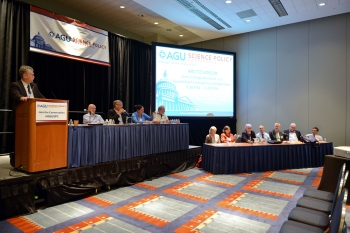
The 2013 Arctic Forum convened on 25 June in Washington D.C. with a focus on U.S. government interagency collaborations to advance Arctic research. The forum, sponsored by ARCUS with funding from NSF's Division of Polar Programs Arctic Sciences Section, was a featured section of the 2013 American Geophysical Union's (AGU) Science Policy Conference: Preparing for our Future.
Moderated by Brendan P. Kelly, Assistant Director, Polar Science, White House Office of Science and Technology Policy (OSTP), the Arctic Forum was organized into three panel sessions. Each panel discussion provided a different perspective on the opportunities and barriers to interagency collaboration in Arctic research, how research objectives are developed, and how the resulting information is shared with policymakers tasked with responding to rapid climate change.
The first session included panelists from the National Aeronautics and Space Administration (NASA), Department of Energy (DOE), National Oceanic and Atmospheric Administration (NOAA), and NSF—four agency members of the Interagency Arctic Research Policy Committee (IARPC). These panelists discussed the role of federal agency research within the context of carbon cycling and the Arctic marine ecosystem. The questions included what policy-makers should know about the carbon cycle, what resources their individual agency contributes to providing those answers, and how interagency collaboration facilitates those goals.
Some of the issues identified as key to policymakers included:
- Understanding the potential causes of abrupt climate change and feedbacks that might amplify the change.
- The basics of carbon sinks and storage.
- How the carbon balance might shift with changing climate.
- How changes interact on a system-wide level.
- The difficulty of developing policy to address these complex challenges.
Panelists observed that research objectives differed from agency to agency. For example, NOAA does both applied and basic research, DOE efforts are organized around carbon since it is the base for most energy, NASA's work focuses on earth system models and related data collection and interpretation systems, and NSF funds basic research in a range of disciplines. Differences in research objectives and approaches, as well as organizational structures and cultures, create barriers to effective interagency communication and collaboration. However, there was general agreement that the effort to participate in IARPC activities is building a systems-based approach to research, helping to manage redundancies, and maximize efficient use of government research support.
During the second session a different group of scientific program directors focused on the impacts of sea ice loss on infrastructure, human health, and marine and terrestrial environments. Panelists for this session included representatives from the U.S. Arctic Research Commission (USARC), Office of Naval Research (ONR), National Institutes of Health (NIH), and NSF's Division of Polar Programs.
The information this panel identified as most critical to policymakers included:
- Understanding that sea ice observations (e.g., where the ice is, how fast it is moving, its condition) are a fundamental need for planning and assessing risks in both civil and research infrastructure.
- The need for improved predictions of when the Arctic will be ice-free in summer and what kinds of vessels will be required.
- An understanding of how climate change affects the lifestyles and associated health and mental health issues of northern communities.
Representatives from international and non-governmental organizations comprised the third session panel. These panelists—from the University of Alberta; the Aleutian/Pribilof Islands Association, Inc.; the Smithsonian Institution; and the global research organization, Battelle-—provided perspectives on the government's role in Arctic research, additional opportunities for interagency collaborations, and potential research gaps. The panelists specifically highlighted several crucial needs and challenges:
- Economic, education, and public health issues rather than science and research generate the primary inputs for public policy.
- Further engagement of local indigenous communities in research activities.
- Understanding non-linear systems and feedback processes.
- Improved communication between agencies, which could facilitate the sort of opportunistic work that is seen in private-sector research.
- Including the costs of supporting collaboration in the initial funding structure.
There was substantial audience participation following each of the three sessions.
In addition to the series of panel discussions, Arctic Forum attendees presented posters during a networking session of the larger Science Policy Conference. An ARCUS poster on "Collaboration and the Science-Policy Nexus in Arctic Research" shared best practices for building and sustaining research networks and for successful cross-disciplinary efforts. For more information about these best practices, please contact Helen Wiggins (helen [at] arcus.org).
For further information about the forum, including the agenda and speakers, please see the AGU Science Policy Conference website.
